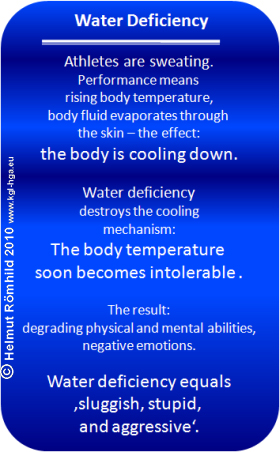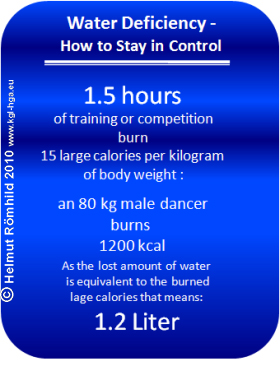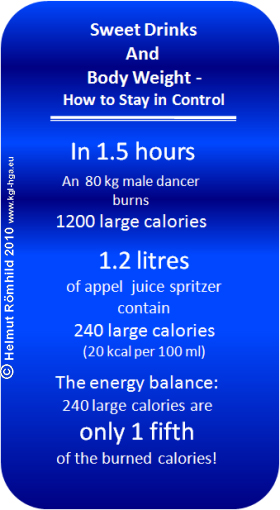1
The Optimal Diet for Dancesport: Water Supply.
Guest Writer: Dr. Erik Wischnewski Editing And Translation: Kerstin Lange Photography, Graphics: Helmut Römhild
well, almost: water accounts for about 60% of the body weight.
The 60/40 balance is normal and must be maintained to keep body and brain functioning.
Already a loss of water equivalent to 10% of the body weight is dangerous, the body will get out of control.
Loosing water is critical but the signals indicating the imbalance are unreliable and in most cases pass unobserved.
Loosing water is normal, a result of the body doing its daily work.
But if more water is lost than replaced the result will be water deficiency.
Just drinking 1/2 litre below the quantity lost per day deprives the body of 7 litres after 2 weeks!
the person being thirsty while the heart starts to beat faster.
A lack of 3 to 4 litres results in dizzyness, headache, and a dry mouth.
A lack of more than 10% of the body weight leads to convulsions and impaired vision.
A rough estimate is 1/2 to 1 litre per hour during a competition or intensive training
A more precise calculation is based on the body weight:
A male dancer of 80 kilograms will loose 1,2 litres during 1 1/2 hours hard work,
a 55 kilogram female dancer will loose almost 0.8 litres.

Dr. Erik Wischnewski
Author of proLife, a systematic approach
to a balanced diet.
www.mit-prolife-gesund-ernaehren.de/prolife.htm
Diet And Dancesport.
To each kind of sport belongs a specific diet: combat sports, sports requiring reactive power, sports requiring endurance ...
Dancing belongs to the competitive games.
In this type of sports the athlete experiences moments of high impact followed by intervals of slow or even no activity.
90 seconds of dancing is followed in most cases by an overlong break,
‘breaks’ also being part of every dance: posing, music suddenly changing tempo ...
In addition dancers need endurance and should be able to instantly accelerate and stop.
All this is typical for soccer, tennis, handball – and they provide the name for this type of sport: games.
Diet and dancesport – what a dancer needs, what a dancer should avoid: in a series of articles Dr. Erik Wischnewski will provide the basics of an optimal diet for dancers.
How can a dancer control the body’s water supply?
The basic rule is to drink fair amounts at regular intervals.
The daily quantity should be 1 litre per 25 kilograms of body weight, for athletes even more: 1 litre per 20 kilograms.
Training and competition means to build a stock of water several hours before and replenishing during the performance.
Thermos bottles (to keep the drink cool!) containing 3 litres are the perfect companions for training and competition.
Again: for each dancer!

No alcohol: it will reduce concentration and coordination – one way to end a career in dancesport.
Persons who don’t like isotonic sports drinks can as well use fruit juice or plain tap water.
Also non-alcoholic malt beer (Vitamalz) will do the job as will herbal tea with a slight amount of sugar.
Even a not so strong coffe is sufficient and better than nothing.
A ‘spritzer’ (apple juice and water) is the perfect choice. It not only brings back the water but also the vitamins and minerals.
Because there is an unpleasant side effect to loosing water:
And of course they are also burned up as a result of the dancer’s work.
A deficiancy in vitamins and minerals occurs if a person doesn’t replenish what was lost.
Minerals are essential for the body functions.
help the muscles do their work: they support the nervous system and the carbohydrate metabolism.
They provide strength for the Viennese Waltz and the Quick Step.
If they fall below a certain threshhold muscle cramps will bring an unpleasent end to the performance.
in other words helps them to contract.
A lack of sodium decreases the muscle’s potential.
Sodium which is one part of the potassium/sodium circulation also controls the body’s water balance.
improves the function of nerves and muscles. A lack of potassium makes the dancer feel slack and weak.
Water deficiency inevitably leads to a lack of minerals.
With each litre of water that evaporates through the skin a person looses up to 1 gram of sodium, 300 milligrams of potassium,
160 milligrams of calcium and 36 milligrams of magnesium.
Also vitamins help the body to do it’s work.
play an important role in the production of energy: B1 as part of the carbohydrate metabolism, B6 as part of the protein metabolism.
are antioxidants and protect substances in the body from damaging oxidation.
Producing sweat means to loose Vitamins: the B and C vitamins are dissolved in body fluids.
Only vitamin E resides in the body fat – deficiency is the result of burning it up while exposed to
higher impact during exercise.
Vitamin B and C deficiency can occur within 24 hours.
Vitamin E loss cumulates into a deficiency only over a longer period – there is a vitamin E reserve
inside the body.
How can a dancer balance vitamins and minerals?
Apple juice ‘spritzer’ is the first choice. Combined with eating wholegrain produce this diet is a perfect way to bring back minerals.
Daily restore the vitamin level by drinking fruit juices.
Eat vitamin B daily. Also bring back vitamin E with your meals, not necessarily every day but make them part of a long term diet plan.
But doesn’t such a diet more or less amount to drinking a lot of juices and other drinks containing sugar?
How does that go together with the dancer’s permanent struggle for an athletic body?
No Problem.
An 80 kilogram male dancer drinking 1.2 litres of apple juice ‘spritzer’ consumes 240 large calories.
But he burned five times the amout: 1200 large calories.
That makes even slimming possible: provided the dancer didn’t end the training with a visit to the favorite fast food outlet the scales will show decreasing body weight.

![]()
©: Ballroom Website, 2009
Aktualisiert: 31.08.2009


